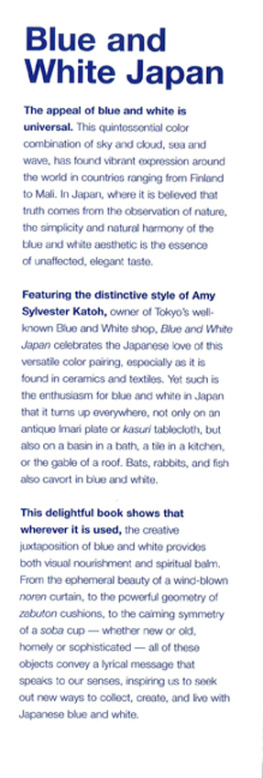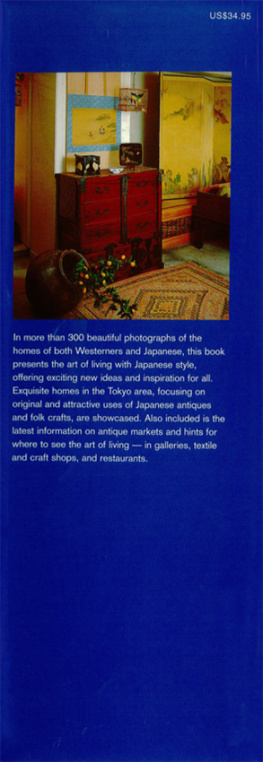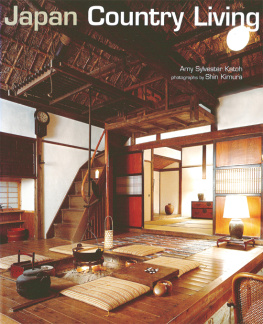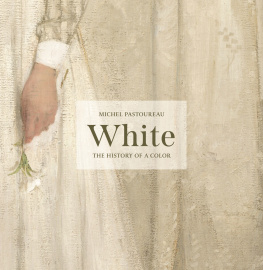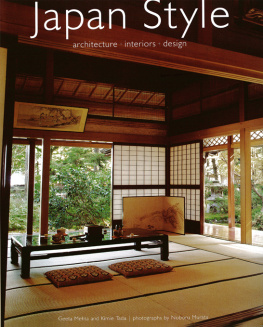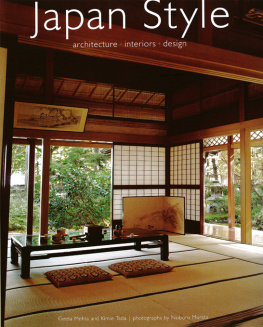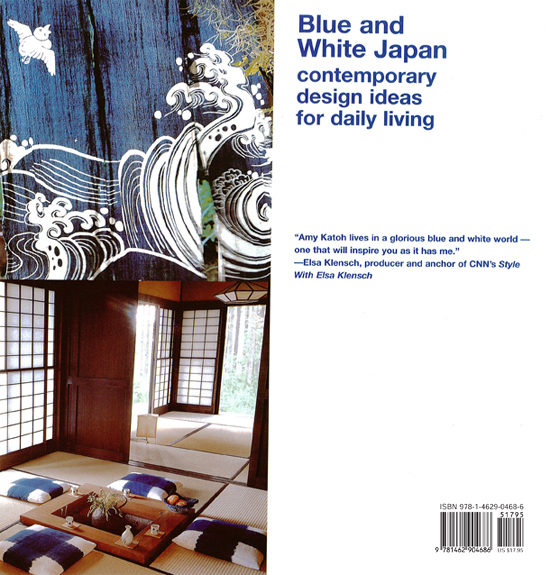Living with blue and white means the focus is on simplicity. Here, peace prevails in the entrance-way of the Sanshiro Ikeda house, moved from Toyama Prefecture twenty-five years ago and faithfully restored in Matsumoto. The lines of the alternating slats of dark wood on the sliding door are repeated in the bamboo pattern of the hemp-fiber noren curtain created by the late Keisuke Serizawa, stencil designer, dyer, and Living National Treasure. On the massive chest are an old quilt and a furoshiki, wrapping cloth.

Rags and riches fill the entrance of the Kupciunas house. Calligraphy on a scroll of washi, Japanese handmade paper, by Naoaki Sakamoto of Paper Nao. The ragweave slippers are from Wajima. A Thai horse looks on.
Entrances not only welcome visitors, they also reflect the taste of those who live within. They are considered the face of the home. What better place to introduce a blue and white sensibility? Blue and white has its own energy and it conveys a message of simplicity and order. Start with basic materials-an Imari umbrella stand, a favorite porcelain hibachi brazier, some antique textiles-then use them in fresh ways to add texture and character to otherwise anonymous spaces. Try wrapping a basket of flowers and branches in an old futon cover of patched indigo. Add a touch of whimsy to an entranceway floor with an arrangement of ragweave sandals and heavy workman's footwear. Consider using noren, the split curtains traditionally hung in shop doorways, to delineate space and serve as creative door dressing. Then, in the Japanese way, change them with the seasons: sheer fabrics for summer, thick cotton indigo in cold weather. The entrance is a place to make a statement about what you love and what gives you energy. Share that energy with all who enter by making it an expression of your individuality. Blue and white is the message. The entrance is the place to communicate it.

Wooden puppet's feet, workman's footwear, and old ragweave sandals join forces.

A floor-to-ceiling indigo bamboo grove with openings cut for arrangements of hydrangeas in front of a sculpted concrete staircase and a child's kimono.
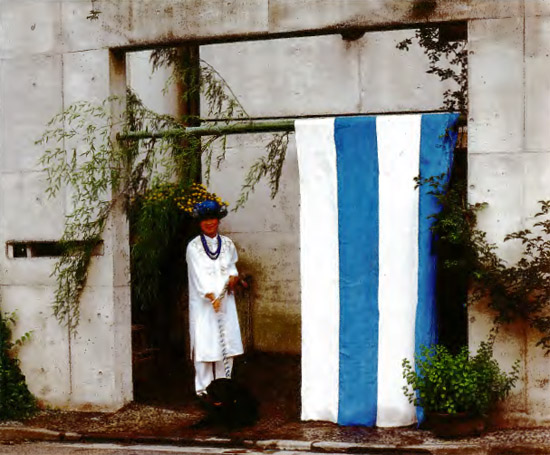
Harumi Nibe, in a tie-dyed indigo hat by Ryoko Kodama, greets guests with her Labrador, Tokiwa Gozen. Next to her, a blue and white hemp curtain fragment draped over a freshly cut bamboo lintel serves as a new take on traditional noren. Transplanted to Tokyo from Shikoku, Nibe-san is a flower and food artist who brings the rich flavor of country sensibilities to whatever she does. Her style is imbued with the Japanese appreciation for rustic and natural things.

Gossamer noren cover a storage cupboard in the display room of Kosoen, an indigo dyer's workshop in Ome, Tokyo. Above the cupboard, a rice-straw bale of fermented indigo sits next to rolls and skeins of undyed cotton thread. On the floor, an old back basket filled with lilies. In the next room are the indigo vats.

A converted temple in Sakakitamura, Nagano, is home, workplace, and showroom for Kibo and Keiko Nomoto, potter/indigo dyer and textile artist respectively. Provisions for going out include an indigo traveling coat, paper umbrella, and covered clogs. Keiko Nomoto's own indigo patchwork collage brightens the wall.
Artful doors. Handsome definers of space that invite us to enter a house or a room, noren can also turn a doorway into a frame for a fluid work of textile art.
Noren are usually dyed with indigo and made of cotton, and sometimes of hemp. They are suspended from a bamboo pole across the front of traditional Japanese shops, where they serve to announce both the name and crest/symbol of an establishment and that it is open for business. When the shop is closed, the noren is removed.
In the eighteenth and nineteenth centuries, streets were lined with shops whose vibrant noren were a compelling testament to the dyer's art. While modern stores do not usually hang noren above their entrances, enough noren- graced doorways still exist to offer practical art opportunities to indigo dyers and designers who seek a canvas on which to exhibit their talents.
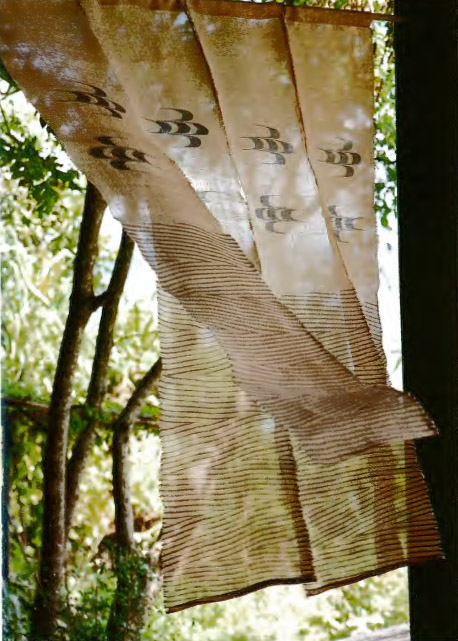
Noren in banana fiber and indigo, spun, woven, and dyed by Toshiko Taira of Okinawa, who has led the movement to preserve the ancient craft of banana-fiber textiles, bashofu.
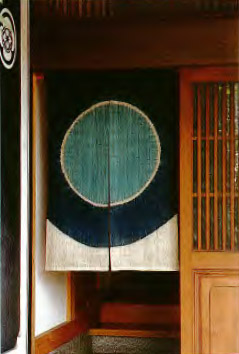
Tie-dyed indigo noren hanging in the doorway of the Kakinoki antique shop in Tokorozawa.

Sheer magic. An appliqued noren of indigo mosquito netting by Kazuko Yoshiura.

Straw cushions on the bay-window seat are favorite spots for tea. Shisa, temple dogs or lions, by Joga Shima, and a large blue and white covered bowl by Kyoshi Matsuda are dwarfed by the massive wall of local travertine in the fireplace.
The best rooms have a certain serenity and clarity of purpose. To the Japanese way of thinking, a main room where guests may visit has to be versatile and beautiful. It should also provide a feeling of well-being. Translated into a Western setting, this means the sort of uncluttered living room where you can put your feet up if you feel like it, throw a party when the spirit moves you, or just sit quietly by the window and daydream, yet always feel refreshed and sustained by things you love. Nestled on a hill in Okinawa overlooking the East China Sea, the room at left meets all these criteria. It is a living room where one is meant to live simply and well. The ever-changing blue and white of sea and sky are an evolving mural, so furniture and other decorative elements have been reduced and downplayed. Instead, the soaring windows provide a spirited sense of place through the use of local craftsmanship in the construction and the addition of blue and white Okinawan textiles and ceramic accents. Used in tandem with other things, blue and white lends a room a relaxed elegance, making it a room to remember.


